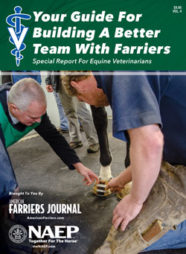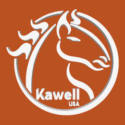A reliable, well-planned portable workstation is a boon for any farrier.
It stores your tools, equipment and supplies. It’s a rolling billboard that promotes your business. Simply put, it’s your office and it needs to serve your needs efficiently to maximize your income potential.
While the price tag is considerable, there are a number of options from which to choose. If you plan to trim horses, a compact car and a minimal set of tools will do the trick. Like most new farriers, if you have a modest client list, a slide-out workstation under a truck bed cap or tonneau — a waterproof metal cover for your truck bed — might fulfill your needs. If you use your vehicle for purposes other than farriery, a trailer might be your best choice. Or, if you are fortunate enough to have a healthy client list, your practice might demand a full-size pickup with a customized body.
With so many choices, here are some questions to ask yourself before committing to such a large investment.
1
What Do I Really Need?
It’s easy to get caught up in the idea of the “dream rig” that’s fully stocked with top-of-the-line tools, inverters and stereo systems. However, you should ask yourself an important question.
“How much do you really need to do your job?” asks Al Creekmore, sales director at Extendobed in Boise, Idaho.
It’s best to keep the bigger picture in mind.
Established farriers, supply companies and manufacturers can help point you in the right direction about which rig will benefit you the most.
The organization of your farrier rig should save you time and money.
Explore financing options to smooth your path to securing a loan.
“We have farriers come in here all the time and say, ‘I want this and I want that,’” says Lou Sposito of Stonewell Bodies in Genoa, N.Y. “You don’t need to buy an inverter when you’re going to shoe one horse a month in a pasture.”
Instead, focus on the necessities and start with a budget.
“Based on the budget you come up with,” advises Brent Chidsey of Bay Horse Innovations in Cynthiana, Ky., “try to focus on the things that are most practical, meaning forges, grinders and storage, as opposed to microwaves, coffeemakers, inverters and those sorts of things.”
Your rig might even have to be built piecemeal.
“I’ve worked with some farriers who, based on where they’re at in their budget, I just start them out with a frame and deck — just a slide-out,” Creekmore says. “I’ll send them the dimensions and some different things they can build out of wood until they get their first couple jobs done. If you don’t need it, don’t buy it. If you need it, but can’t afford it, then here’s what you can do to get by until you get a few jobs under your belt. Then, let’s get this thing built for you.
“The most important thing is to get you working. You have to get out there and make a living. We don’t want new farriers to dig themselves into a hole before they can get going and then they can’t get out of it. We try to be very budget conscious on what we’re doing to help them in the early stages as they grow.”
Your location, clientele and lifestyle play a vital role in your rig choice.
“You need to know your clientele before deciding whether you are going to need a bigger rig, smaller rig, a cap on their truck or a trailer,” explains Jeremey Fox, a representative of Finger Lakes Custom Manufacturing in Skaneateles, N.Y. “You have to figure out what’s going to best suit where you’re traveling and what you’re doing.”
If you live in a climate that encounters snow, a four-wheel drive truck might be the best choice. However, if you’re working in a rural setting, a trailer might suit your needs.

A swing-out anvil is one of the most efficient features that a farrier can add to a rig. It spares you the necessity of picking up and carrying your anvil several times a day. Photo: Georgia Farrier Supply
“It all comes down to your lifestyle,” Chidsey says. “You have to ask yourself, what are your needs at this point in your life?”
If you already have a truck, your choices certainly aren’t limited.
“A cap is definitely a beautiful starter if you just want to get a nice rig set up,” says Neal Purdy, owner of Finger Lakes Custom Manufacturing. “It’s all in what you can afford. I understand these are big purchases, but they don’t have to be. They can be functional and affordable. The extras that would be nice to have and don’t really need can come with time.”
A similar choice that is relatively cost-effective is a tonneau cover.
“A tonneau cover with an anvil swing-out is a very efficient unit,” suggests John Halko of Georgia Farrier Supply in Jasper, Ga. “Your fuel efficiency is probably 20% better than with a full truck body.”
Combining a tonneau cover or cap with a customized slide-out workstation enables your rig to grow with your practice.
“Outside the vehicle, you have full access of all your tools from every side in an unconfined space,” Creekmore explains. “As you progress and get into your own routine as far as how you like to do things, you can modify it by adding a shoe rack or make a narrow tool rack bigger, longer or wider. It’s a tool that you will grow your farrier business around and not have to replace as you go.”

A well-organized farrier rig keeps most of your equipment within arm’s reach to maximize efficiency. Photo: Finger Lakes Custom Manufacturing
2
How Can My Choice Improve My Efficiency?
A rig should provide a farrier with a smooth and fluid center of operation that maximizes efficiency. Any wasted movement costs you time and money.
“It’s all about organization and a smooth workflow, as far as setup goes,” Purdy says. “These things are like snowflakes — there are no two alike. We really involve the person in the setup and how they like to see it flow. We’ll throw suggestions in there, whether they take them is up to the customer.”
Heeding that advice is a good idea, especially considering the thousands upon thousands of rigs they have made over the years.
“A shoeing rig is like working in a factory,” Halko says. “You don’t make a widget at station A, then take it 20 feet away to put a hole in it at station B. You try to do all of your operations right there in one area. Everything should be within arm’s length.”
One example in which a swing-out tool can improve efficiency is the aforementioned anvil.
“An anvil swing-out doesn’t cost you anything,” Halko says. “The average farrier can shoe eight horses a day. If a farrier charges $100 a horse, that’s $800 a day. But with an anvil swing-out, a farrier can do nine horses a day. So after a week, the anvil swing-out is paid for. It puts $100 in your pocket after the first week, every day for as long as you shoe horses. That’s about the energy it gains you for the average full-time farrier. That’s the dollars and cents of it.”
Just because you’re confined to a smaller vehicle, doesn’t mean that you don’t have the space to accommodate your needs.

A slide-out workstation offers full access to all of your tools from every side in an unconfi ned space, while also having the fl exibility to modify the accessories as you grow into your practice. Photo: GExtendobed
“You can maximize your space through shelving, drawers and other accessories,” Creekmore says. “I have a client who told me, ‘I’m able to get 40% more material in my truck than before. Everything has a spot. I’m able to stack and put things in particular places to utilize the space better.’”
Focusing on the necessities of your practice often increases efficiency.
“After a farrier has been in the business for awhile, they realize they really don’t need all of this stuff and you see them begin to downsize,” says Chidsey, who started as a farrier 25 years ago in Ithaca, N.Y. “The most common thing I hear when a farrier changes rigs is, ‘I cleaned out my rig and I found stuff that I haven’t used in 5 years.’”
Fuel prices remain high (the average 2016 mid-summer price for regular gasoline per gallon is $2.91, while diesel is $2.42, according to the U.S. Energy Information Administration). As a result, more manufacturers are seeing farriers move to smaller rigs.
“There’s a lot of attention being given to fuel efficiency,” Sposito says. “We’ve seen rigs that have gone from large, dually rigs to the introduction of Sprinter and Transit vans, as well as an upswing in trailer sales.”
If cost efficiency is your top priority, there are two options to consider.
“If you break it down, a cap is going to be the most efficient, just simply because of weight,” Fox says. “A cap and a body are going to be similar because when a body is put on, the bed of the pickup comes off. I’ve found that a trailer knocks off 2 to 3 miles a gallon for most vehicles.”
The materials used to build the rigs also play a role in saving fuel.
“If the customer just really wants a dually, the best thing we can do is keep the rig light, keep it aerodynamic and manage the amount of content for weight reduction, usability and space,” Sposito explains. “Trailers are very light and can be unhitched from the vehicle when a farrier’s not working.”

A trailer gives you the freedom to use your truck for both business and professional purposes.
3
How Do I Pay For A Rig?
In the case of Extendobed and other manufacturers of slide-out workstations, you will be billed directly.
“We will do a 50/50 split — 50% down when you order,” Creekmore explains, “and 50% when we ship it.”
Unless you’re starting your practice with a lot of cash on hand, more than likely you’ll have to secure a loan or a lease for other rigs.
“When you’re starting a new business, financing is more difficult than an existing business,” says Gregg McGuire of Ohio-based Financial Services Unlimited. “A new business is considered less than 2 years. If you’ve been in business less than 2 years, typically your credit score should be 650 or better and need to put down 10% to 20%. The better the credit score, the less money needed for a down payment.”
You also must demonstrate your ability to successfully perform in the trade.
“We will help them to basically do a bio, so we can understand what their experience is in the industry,” he says. “Do they have any previous business experience? He or she might have been a contractor before deciding to become a farrier. Where did he or she learn to shoe?”
Regardless of whether you choose a loan or a lease, the credit requirements will be similar.
“Some think you don’t need strong credit to lease equipment,” McGuire says. “That’s not the case. In today’s market, you need strong credit regardless of a lease or a loan.”
It’s important to be well prepared before approaching any financial institution.
“Be very cautious of who you choose to work with,” he says. “You want to do some research on finance companies. If they require that you give them money up front to finance this piece of equipment, then you need to go to somebody else.”
There are advantages and disadvantages to both options.
- Loan: Under normal situations, securing a loan through a traditional bank or credit union for an automobile or a house is relatively straightforward. You’ll likely find more obstacles when trying to finance a farrier rig.

Slide-outs allow farriers to use equipment such as drill presses and grinders more easily. They also maximize space for efficient storage. Photo: Stonewell Bodies & Machine Inc.
“Typically,” McGuire says, “banks will not lend for these rigs because they don’t understand the farrier industry nor the rigs.”
Halko finds the same reluctance.
“They’re not familiar with them,” he explains. “They’ll lend $50,000 for a car, but they’re reluctant to lend $20,000 for a shoeing rig because they don’t know what it is. They would rather turn it down than approve it because they’re not sure how to handle it.”
Purdy has found that banks are more likely to lend money for specific rigs than others.
“Banks are less apt to finance a truck body because it’s a big ordeal to get the body off the truck if it’s repossessed,” he says. “It’s easier to finance a trailer. Generally, it’s really easy. We work with the banks all the time to make this as easy as possible.”
Here are some recommendations to help smooth the path toward securing a loan:
- Schedule an appointment with a key leader of the lending institution. “Sometimes talking with a loan officer doesn’t work well,” he says. “But, if you can talk to the vice president or president of the bank, and explain your situation, then they see this as a work item. This is something that can make them some money.”
-
Walk the bank officer through the manufacturer’s website, explain what a rig is and how it’s critical to your business. The full process of obtaining a loan often takes a couple of weeks.
“Educate the banker, put as much money down as you can possibly afford, and if you do some homework and work with the bank, you’ll usually get the loan,” Halko says. “If you walk into a bank cold, especially a small town bank, it can be a little difficult to borrow money.”
If you still receive a cool reception, some manufacturers can recommend lending institutions that are familiar with the horseshoeing trade and more open to lending to farriers.
- Lease: Leasing a farrier rig probably is the easiest and less time-consuming option. However, interest rates generally are higher than a traditional bank loan.
“You’re always going to pay higher interest rates with a leasing company,” Halko says. “That’s just the way it is.”
While it might take some time to secure a traditional bank loan, attaining a lease can be relatively fast.
“Usually you’ll have an answer within 36 hours from the leasing companies,” he says. “There’s instant gratification there.”
5 Ways To Outfit Your Pickup








